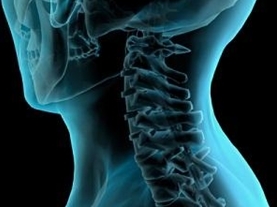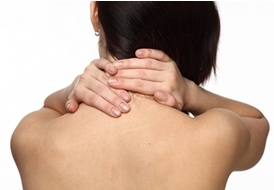
Osteochondrosis is a disease of the musculoskeletal system. According to statistics, about 90% of the population suffers from the disease. A large number of patients are not even aware of this, as the early form of the disease develops asymptomatically.
Other parts of people periodically just feel uncomfortable in the back area, write down as tired and untreated. Among all types of osteochondrosis, defeat of the cervical spine occurs. If treatment is started on time, it is possible to get rid of the disease.
The essence of osteochondrosis
Two mechanisms are involved in the development of osteochondrosis: dystrophic and degenerative. The first indicates a violation of trophism (nutrition) of the intervertebral cartilage (disc). The second is due to dystrophy - organic changes in the structure of cartilage and vertebral tissue.
The essence of the disease is as follows: circulatory disorders in certain areas in the back cause thinning and dehydration of cartilage tissue. Along with fluids, it loses its nutritional components. As a result, the cartilage loses elasticity and firmness - it slackens. The distance between the vertebrae decreases, its stiffness is violated (position stiffness). They can move and nest against each other, while pinching nerve roots.
With osteochondrosis, cartilage deteriorates at an accelerated rate.
If dystrophy persists, the muscles that support the spine will also lose tone. Vertebra slack more. Due to the increased friction, protrusion develops - damage to the cartilage capsule with the protrusion of its contents outward.
Next, the natural defense mechanism of the spine is triggered. Bone growth - osteophytes appear on it. They must ensure a stable vertebral position. However, osteophyte growth often exceeds the "need". Excessive growth also puts pressure on the remnants of cartilage and nerve fibers. Moreover, they are strong. The spine loses its elasticity, the "adjacent disc" can be damaged. The patient loses mobility, suffering from severe pain. The result of advanced osteochondrosis is disability.
Due to blood congestion, osteochondrosis is accompanied by the deposition of salts in the area near the cartilage. Such "accumulation" worsens the progression of the disease, accelerating damage to the cartilage and spine.
Why the neck is more often injured
The cervical spine is the most sensitive and fragile. The elements are the smallest and are not adapted to heavy loads. However, the neck muscles are not involved in all types of physical activity. Thus, chronic blood congestion and malnutrition in the vertebral joints. If a person does not play sports, the risk of cervical osteochondrosis increases significantly. Most people rarely use their necks for routine tasks.
The leading cause of osteochondrosis is a hypodynamic lifestyle. Lack of exercise, combined with passive relaxation, causes muscle weakness and vascular tone disorders. Provoking neck disease stays long in one position. Osteochondrosis of the cervical spine is considered by many office workers and computer scientists.
Excessive physical activity causes muscle hypertension. Always in a tense state, they also provoke the stagnant process. Indirect causes of this disease include improper nutrition (excess salt and fat in food), metabolic disorders. The disease can be triggered by autoimmune processes, nutrient deficiencies (vitamins and minerals), endocrine diseases and psychoemotional shock (as it is also accompanied by muscle stress).
How to recognize cervical osteochondrosis

Early osteochondrosis does not manifest itself in any way. In the first stage of development, the cartilage is dehydrated. It is invisible from the outside, does not cause physical discomfort. The disease can be found by chance, when examining the spine for injuries or other complaints.
In stage 2, cartilage deteriorates. Its height decreases, its amortization capacity decreases. Early symptoms may appear at this stage. Their features are periodic. The discomfort in the neck felt clear, then subsided. Periodically disappear completely. One sometimes feels pain in the neck. They appear after physical exercise or long stay in one position (sitting or standing). Unpleasant sensations appear in the morning, when patients "pause" they weaken and remind themselves in the late afternoon. If salt is stored in the cervical area, one will hear cracks in the spine while turning. "Clicking" while tilting the head is not painful.
At Level 3, nerve roots may be partially trapped. This is accompanied by a severe painful sensation. The patient complained of lumbago and sudden pain in the neck. Discomfort occurs after static position. In contrast to the early stages, it is more often worrying. A person's neck "becomes tired" in a short time. There may also be pain. They attack patients in the evening and at night.
Congestion in the cervical spine causes cerebrovascular accidents. It is manifested by headache (sometimes migraine), tinnitus, dizziness. With persistent hypoxia (lack of oxygen) there is a feeling of "goose bumps" on the scalp, often on one side. There are also secondary symptoms - patients get tired quickly, feel weak, drowsy (for no apparent reason), sometimes disturbed sleep.
In line with the symptoms listed, the movement of the joints in the cervical spine changes. Some movement of the head or neck is accompanied by sharp pain. Patients unconsciously reduce their amplitude, striving to maintain a comfortable position.
Stage 4 osteochondrosis is accompanied by the protrusion and appearance of osteophytes. Violation of nerve roots that causes persistent pain syndrome. If inflammation develops in the process of change, the pain becomes permanent. A person experiences an increasing number of headaches, visual disturbances (deterioration of vision at dusk, "flies", blurred images). Neck mobility is very limited. Patients avoid twisting the neck, if necessary, twisting the whole body. When nerves are damaged, pain, "goose bumps" or numbness on the shoulder blades, shoulders, forearms and even hands occur.
Diagnostics

The above complaint should be submitted to a neurologist, orthopedist or vertebrologist. The doctor will interview the patient, conduct an examination. During the examination, he or she will check for point sensitivity, reflexes, cervical spine movement. If you suspect osteochondrosis, he or she will prescribe additional examinations. It includes X-rays of the cervical spine in several projections.
If there are no specific abnormalities on the X-ray, but the patient still has a complaint, an MRI or CT scan is prescribed. With this method, osteochondrosis can be detected even at an early stage.
How to be treated
Although the patient has all the signs of osteochondrosis, it is best to see a doctor. Only a specialist can assess the scale of destruction objectively, differentiate condrosis from other diseases, make a correct diagnosis and choose an individual treatment regimen.
This disease takes a long time to develop. Exacerbations of osteochondrosis can occur periodically and disappear on their own. The patient still needs to be examined.
This disease is treated on an outpatient basis. Surgical intervention (to get rid of osteophytes) is an extreme action used only for serious damage to nerve roots with severe pain. Conservative treatment can almost always be removed.
Osteochondrosis (depending on the stage) is treated from 1 to 3 months. Therapy should be thorough. Self-medication is very much needed here. Even after improvement, patients must control their activities and take preventative measures. The main task of treatment is to stop the degenerative process. Relieving symptoms with medication temporarily relieves the patient's condition. There are several ways to treat osteochondrosis at home.
Drug therapy
With the help of medicines, you can eliminate inflammation, relieve pain, supply the body with useful nutrients and improve the nutrition of cervical spine cartilage. Painkillers are used as a symptomatic treatment. In the inflammatory process, the pain is relieved with the help of NSAIDs. The drug is prescribed in tablet form (if the symptoms are mild) or injections (if the pain is severe).
To get rid of muscle hypertonics, muscle relaxation is prescribed in parallel with NSAIDs. These funds enhance the effects of painkillers, giving them “free access” to the focus of inflammation. Pain medication is used as short as possible (5-10 days) due to the risk of side effects.
Chondroprotectors are prescribed to increase elasticity and restore cartilage. In the acute period, this is an injection. Doctors recommend taking long-term capsules or tablets (3-6 months) as maintenance therapy.
To increase the effectiveness of treatment, taking pills can be combined with the use of external agents (ointments, gels, patches). Spices of pepper or bulbs, painkillers ointment will relieve severe pain. Furthermore, osteochondrosis can be treated with chondroprotective ointment.
To improve trophism in the joints, vitamin B and vascular preparations are prescribed.
People's solution

In traditional medicine recipes there are many recommendations for the treatment of osteochondrosis. Like the traditional approach, folk remedies can be used internally or externally.
Most Potential Topical Mix:
- Compress the radish.Carrot root is rubbed on a fine grater, spread on cheesecloth cloth, applied to the neck, covered with film, wrapped in a bandage, left for 2 hours, washed with clean water, this procedure is performed for 10 consecutive days before bed.
- Compress with potatoes. Rub 3 large potatoes, add 1 tablespoon of honey and 1 tablespoon of mustard, spread the mixture on the cheesecloth cloth and stick to the sore area for 1 hour, apply compress 2 times a day for 2 weeks.
- Red pepper lotion.2 hot red peppercorns crushed into gruel, mixed with chopped aloe leaves, poured with a glass of alcohol, a day later, gauze soaked in the mixture, applied to the neck for 15-20 minutes, washed with cold water. The treatment lasted for 2 weeks.
Compress with mustard and pepper is good for improving blood circulation.
In it you can take infusions, decoctions and tinctures. All recipes aim to normalize metabolism, remove salt, eliminate inflammation:
- Parsley broth.3 tablespoons of parsley grinded in a coffee grinder. Pour the mass with one liter of boiling water, boil over low heat for 10-15 minutes. After complete cooling, strain. It is taken orally 100 ml 2 times a day for 15 days.
- Barberry tincture.10 g of a mixture of dried roots and barberry bark (can be purchased at the pharmacy or from an herbalist) is poured with 100 ml of alcohol or vodka. The mixture was placed in a dark place for 10 days. After straining, take 30 drops orally three times a day for half an hour before meals.
- Celery infusion.Pour a tablespoon of grated celery root with one liter of water. Boil over low heat, turn off immediately. After a day, strain, take 3 tablespoons before meals three times a day. Treatment lasts for 1 month.
Before using traditional medicine, you should make sure that you are not allergic to its components. If a strong burning sensation occurs while applying the compress, you will need to remove the bandage and rinse the remnants of the mixture with running water.
Physiotherapy, exercise therapy and massage

Physiotherapy is often prescribed by doctors to treat osteochondrosis. This can be heating with medical ultraviolet light, exposure to low frequency current, magnetotherapy, electrophoresis or phonophoresis. Such manipulations are performed in hospitals, using special equipment. They eliminate inflammation and increase drug access to cartilage tissue. The combination of medication and physical therapy can quickly eliminate the unpleasant symptoms. This course requires 10-15 procedures. To get stable results, all types of physiotherapy must be fully completed (do not be disturbed).
Physical therapy for the treatment of osteochondrosis of the neck includes moderate exercise. They can be done freely in the morning and evening, as well as between workplaces. Physical education can be done while sitting or standing.
The following exercises can be included in exercises for cervical osteochondrosis:
- For 2 minutes, turn your head first clockwise and then counterclockwise (2 sets);
- lower your head smoothly forward, backward and sideways (15 times in each direction);
- lift the shoulders as high as possible, so that the neck and head do not move (15-20 times);
- rotate shoulders forward or backward, keeping neck and head immobile (1 minute in each direction);
- fold your palms, press your fingertips in the middle of the forehead, smoothly toward the temporal area, along the neck, to the collarbone (10 times);
- without changing the position of the chin, bring the neck back smoothly (chin pulled in), then forward, to the side (without tilting or turning the face);
- gather your palms on the locks behind your back, pull your arms back, lift and stretch your neck as high as possible, staying in an extended position for 15 seconds (3 times).
For osteochondrosis, massage is considered the best method to improve blood circulation in the neck. It is best if the patient undergoes a full course (10-15 sessions) with a trained specialist. If this is not possible, you can knead your own neck at home.
Self Massage Startup Guide:
- first, the neck muscles should be warmed up: rub the back of the head with the attachment of the fingers or the edges of the palms;
- kneading involves gentle pressure followed by muscle relaxation - kneading with 4 collected pads and thumb;
- slightly pinches the skin around the neck to improve blood circulation;
- by light finger pressure on both sides of the spine, traversing the entire cervical region;
- To relax the back of the head, pat gently with the palm or finger.
Each stage of the sequence ends with a light stroke in the palm of your hand. To enhance the effect, the neck is massaged with ointment. After the massage, you need to make sure that the cervical area is in a warm state.
Massage your neck only with your palms or fingertips (not your fists).

All methods of treating osteochondrosis should be supplemented with diet. The classic healthy diet involves the consumption of lean meats, fish, seafood, whole grain cereals, and lots of vegetables. Food must be boiled, roasted or steamed.
For the duration of the diet, you need to reduce the amount of salt consumed, give up fast food and sweets. It is important to drink at least 1. 5 liters of water daily. It is useful to eat jelly and jelly to strengthen the joints.
With an integrated approach, the symptoms of the disease will disappear within a week, and cartilage destruction will be completely stopped.



































